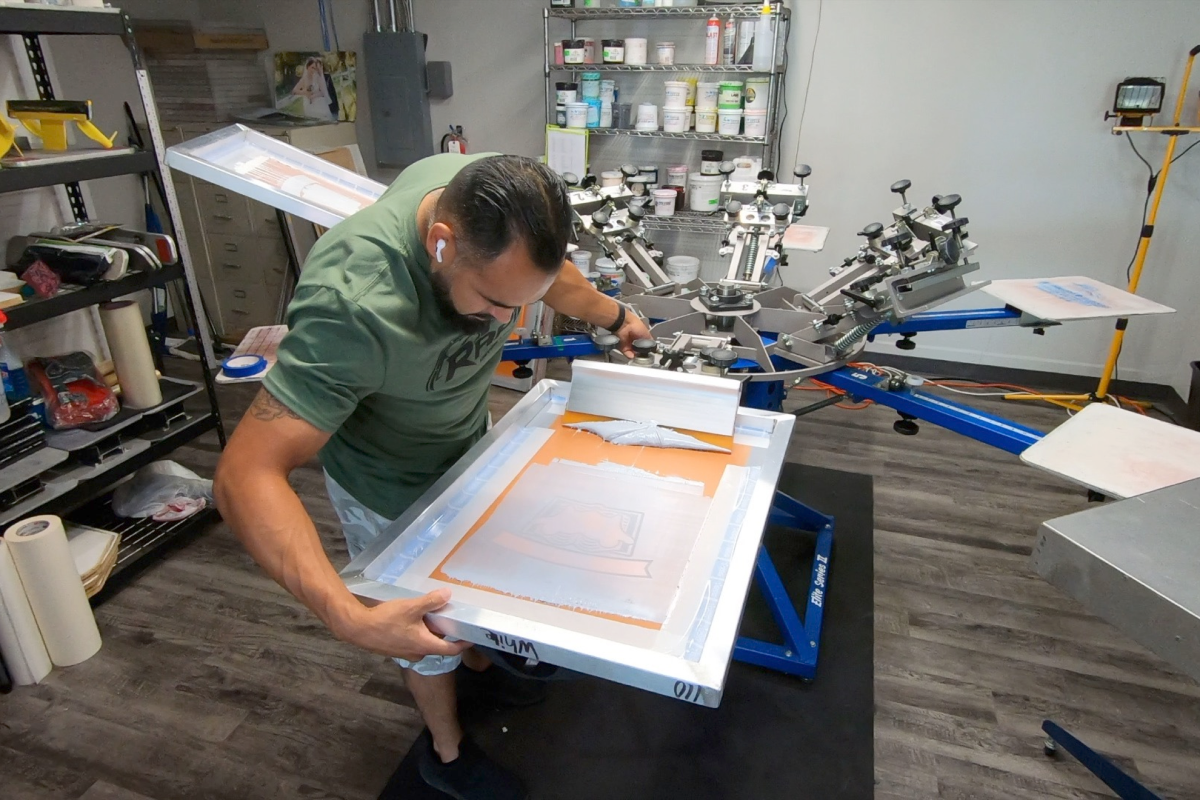Heat press machines use heat and pressure to transfer designs onto materials of all types. The technology helps businesses print company shirts and create special promotional items. Professional results depend on understanding the machine's operation.
Heat Press Basics
Heat press machines are a huge part of modern customization technology. These machines use precise heat and pressure to imprint designs onto different substrates. Companies like Rapid Printing use these machines to create custom apparel and promotional items.
.png)
What is a heat press and how does it work
Heat presses work on a simple principle that combines heat, pressure, and time. The machine transfers designs onto materials by using a heated platen that presses against a lower platen with the substrate. Special transfer materials permanently stick to various surfaces through this process.
Important components of a heat press machine
Modern heat presses need several components that work together.
-
Upper heated platen (makes and spreads heat)
-
Lower platen (provides the working surface)
-
Digital control panel (controls temperature and timing)
-
Pressure adjustment mechanism
-
Timer controls
Different types of heat press applications
These machines have a bunch of applications. You can use several transfer methods.
-
Textile Applications
-
Custom t-shirts and apparel
-
Athletic wear and uniforms
-
Promotional bags and accessories
-
-
Specialty Items
-
Ceramic mugs and plates
-
Metal signage
-
Wood products
-
Heat presses work with multiple materials like cotton, polyester, nylon, and leather. This makes them a great way to get customization services for businesses.
Choosing the Right Heat Press
Businesses need to think about several important factors that affect operations and product quality when they pick a heat press machine. Companies like Rapid Printing that provide custom printing services need the right equipment to deliver professional results every time.
.png)
Size considerations and workspace requirements
A heat press's size affects both productivity and how you use your space. Standard heat press sizes range from 15"x15" to 16"x20", and you can find larger ones for special needs.
-
Small (9"x12" to 14"x16"): Works best for hobbyists and small items
-
Standard (15"x15" to 16"x16"): Great for most decorators and regular t-shirt printing
-
Large (16"x20"): Best for high-volume production and bigger designs
Manual vs. automatic options
Your choice between manual and automatic operation will affect your productivity and how easy the machine is to use. Manual heat presses need physical effort to open and close, which makes them good for lower production volumes. Automatic presses cost more but give you benefits like auto-opening features that help workers not get so fatigued during high-volume production. These machines really help when you're pressing 20-30 shirts at once because they keep quality consistent and lower physical strain.
Important Heat Press Settings
Professional-quality transfers on materials of all types need proper configuration of a heat press machine's settings. Custom printing businesses must understand these settings to deliver consistent results.

Temperature control and accuracy
Heat transfer success depends on exact temperature control,with optimal results at 375° to 425° F. The heating platen's temperature must spread evenly because uneven heating can ruin transfers or damage materials. Different materials need specific temperatures.
-
Polyester: 270° F to apply gently
-
Cotton: 380° F to last longer
-
Specialty materials: 320-350° F to create unique finishes
Pressure settings for different materials
The type of material determines the appropriate pressure settings for quality transfers when using manual presses. Light pressure (25-30 psi) is ideal for delicate materials and simple transfers, medium pressure (32-38 psi) suits standard applications and most fabrics, and firm pressure (40 psi or higher) is best for heavy-duty materials and specialty items.
Time duration guidelines
Different materials and transfer types require specific time settings to make sure you get successful results. Cotton and similar materials typically need a 12-second original press followed by a 3-second follow-up to adhere properly, while specialty materials like sublimation require 35-45 seconds for complete transfers. Achieving the right balance of temperature, pressure, and time is key because incorrect settings can cause failed transfers, poor adhesion, or material damage.
Common Heat Press Projects
Heat press technology has transformed the customization industry and offers applications in many product categories.
T-shirt and apparel printing techniques
Custom apparel decoration remains the most popular use of heat press machines. Modern heat press techniques include sublimation printing for long-lasting designs on polyester fabrics, and heat transfer vinyl (HTV) creates bold graphics on various garments. Plastisol heat transfers provide a professional screen-printed finish that maintains quality through multiple washes for sportswear and promotional products.
Specialty items
Heat press machines excel at customizing promotional products beyond traditional apparel. The technology allows for precise design application on these items.
-
Mugs and drinkware
-
Caps and hats
-
Bags and accessories
-
Promotional items
-
Custom patches
Do You Need Heat Press Services?
Rapid Printing showcases this expertise every day in Victoria, Texas. Our team uses professional-grade heat press equipment to create custom t-shirts, promotional items, and specialty products for local businesses. We've become skilled at controlling temperature, pressure, and timing settings to make sure each project matches exact requests. Contact us today for heat press services!
Heat Press FAQs
What are the important components of a heat press machine?
A heat press machine typically consists of an upper heated platen, a lower platen, a digital control panel, a pressure adjustment mechanism, and timer controls.
How do I choose the right size heat press for my needs?
Consider your workspace and production volume. Small presses (9"x12" to 14"x16") are ideal for hobbyists, standard sizes (15"x15" to 16"x16") suit most decorators, and large presses (16"x20") are best for high-volume production.
What are the key settings to consider when using a heat press?
The three essential settings for a heat press are temperature, pressure, and time. Temperature typically ranges from 375° to 425°F, pressure varies from light (25-30 psi) to firm (40+ psi), and time settings depend on the material and transfer type, usually ranging from 12 to 45 seconds.
What types of projects can I create with a heat press?
Heat presses can be used for various projects including custom t-shirts and apparel, promotional items like mugs and hats, bags, accessories, and even specialty items such as ceramic plates and metal signage.
What materials work best with heat press technology?
Heat presses work well with a variety of materials, including cotton, polyester, nylon, and even leather.
